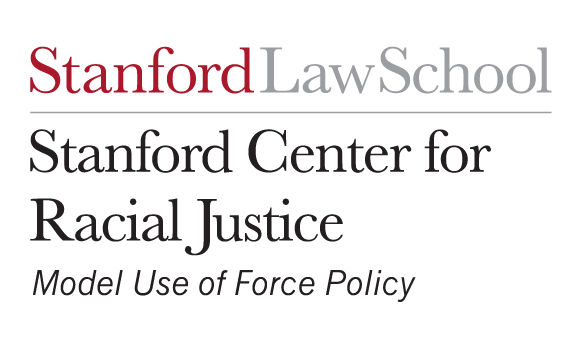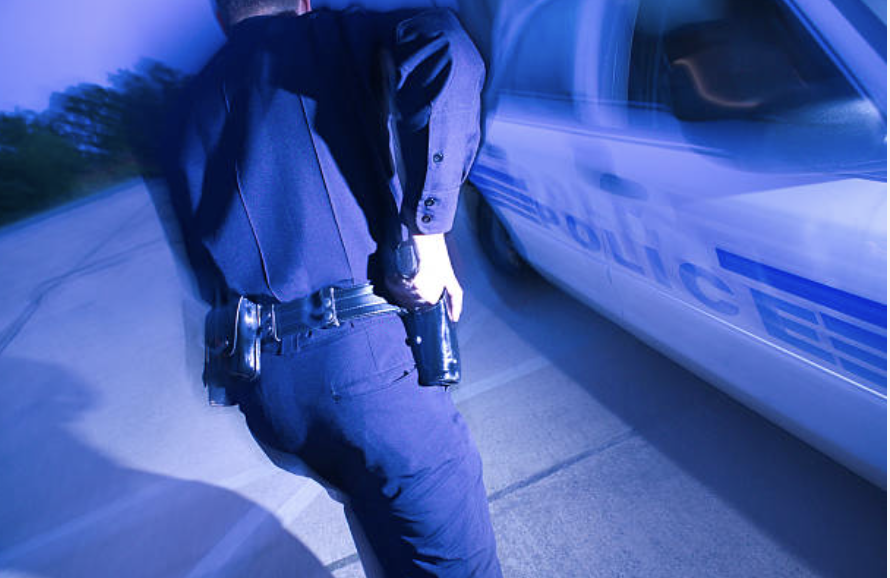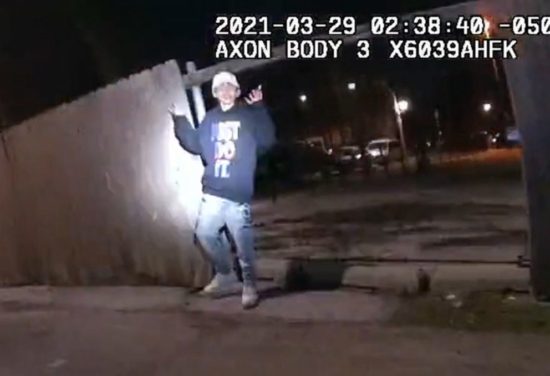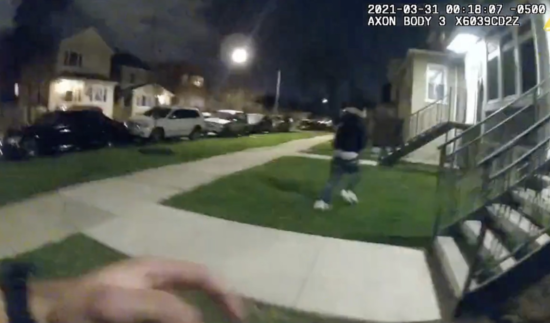The Dangers of Police Foot Pursuits
The Stanford Center for Racial Justice has begun publishing chapters of our comprehensive Model Use of Force Policy in beta release. The Model Policy is intended to contribute to the long line of efforts to improve and reform policing and promote practices that will be fair, safe, and equitable for everyone. This essay is a continuation of our staff’s discussion examining how the Model Policy interacts with scenarios officers may find themselves in. Read Chapter 5 of the Model Policy—Foot Pursuits—here.

On March 29, 2021, Chicago officers responded to a Shotspotter alert—a gun detection system that provides officers with the estimated location of gunshots. When the officers arrived, they found two males walking down an alley—one of whom is now known to be Adam Toledo. When the officers approached both males in their vehicle, Toledo and his acquaintance began to flee on foot. One officer chased and tackled Toledo’s acquaintance and then handcuffed him. The other officer, Eric Stillman, pursued Toledo on foot down the alley and shouted verbal commands for Toledo to stop and show his hands. Toledo held his waistband as he ran and when he got to a fence in the back of a high school, stopped adjacent to the alley. While Toledo faced the fence, Stillman observed a gun in Toledo’s right hand. Stillman ordered Toledo to drop the gun. As Toledo turned around, he raised his left hand while his right hand tossed the gun along the fence line. When Toledo raised his right hand, Stillman shot Toledo in the chest, which knocked Toledo to the ground. Despite Stillman’s efforts to render aid, Toledo was pronounced dead on the scene. Toledo was 13-years-old when he was killed by Stillman.
In an unrelated foot pursuit one day after Toledo’s death, while Chicago officers drove on their routine patrol, officers observed Anthony Alvarez walking with a bag of food in his hand. Officers pulled up behind Alvarez—intending to question him about a suspicion that he had been driving with a suspended license. They saw Alvarez a day earlier but did not stop him. When the officers turned on their lights, Alvarez dropped the bag in his hand and began running.
As Alvarez began to run, he clutched his hands to hold his waistband. Initially, the officers pursued Alvarez from their police vehicle, but began pursuing Alvarez on foot when he ran through a gangway between two houses. Alvarez ran through the gangway and exited out into an alley. As he ran through the alley, one officer noticed Alvarez continue to reach for his waistband. The other officer commanded Alvarez to stop. Alvarez continued running. He ran through the alley and turned the corner onto a residential street, where officers lost sight of him.
When Alvarez turned, he fell twice to the ground. However, officers did not notice his fall. Officer Evan Solano turned the corner and saw Alvarez with a gun in his right hand. Alvarez got up and attempted to run. Solano ordered Alvarez to drop the gun. While Alvarez continued to run, Solano fired five successive shots at Alvarez’s back. Alvarez collapsed to the ground and dropped his gun. Alvarez was transported to the hospital where he was pronounced dead.
These tragic incidents demonstrate the dangers presented during foot pursuits and the deadly consequences that may result. Recently, we released Chapter 5 of our Model Policy, outlining policies to reduce the dangers of foot pursuits. In this essay, we illuminate the risks in initiating a foot pursuit by explaining what led to Toledo’s and Alvarez’s deaths and how our Model Policy may mitigate such dangers.
Why are there foot pursuit guidelines in the SCRJ Model Policy?

A foot pursuit is not a use of force but is often associated with encounters resulting in force. Consequently, in our Model Policy, we include guidelines for preventing, initiating, conducting, terminating, and reporting on a foot pursuit. Guidelines on foot pursuits are important because the guidelines can affect the frequency with which officers use deadly and other escalating uses of force.
For instance, over an eight-year period in Chicago, half of all police shootings occurred immediately after or in conjunction with foot pursuits. In Los Angeles, around a quarter of officer-involved shootings involved foot pursuits. And in Philadelphia, that number was 48 percent. These studies highlight the dangers involving police foot pursuits—dangers that often may put officers at a tactical disadvantage. To further reduce the dangers to the officer’s and public’s safety, an officer may decide to apprehend an individual at a later point. Policies that discourage officers from initiating or continuing foot pursuits may also reduce the number of situations where force becomes necessary.
What are the foot pursuit provisions under the SCRJ Model Policy?
The frequency with which police shootings occur in connection with foot pursuits is one reason the Model Policy “prioritizes preventing the need for a foot pursuit in the first instance.” The Model Policy also emphasizes the inherent danger in foot pursuits and notes the risks that occur from the adrenaline rush and fatigue that may impair an officer’s judgment. To that end, the Model Policy provides strategies—like tactical positioning, body language, and demeanor—to prevent a foot pursuit.
The Model Policy also outlines when an officer is authorized to initiate a pursuit. The Policy permits officers to initiate a pursuit when the officer meets legal justifications to detain the individual and when the benefit of apprehending the individual outweighs the risks to the public and officer’s safety. This risk and benefit balancing ensures that police are prioritizing their own and the public’s safety. The risks that officers must weigh to initiate a foot pursuit include:
- “whether the officer is acting alone;”
- “whether the officer is unfamiliar with the area;”
- “whether the area is hostile;”
- “whether the individuals being pursued are known or suspected to be armed;”
- “whether the officer is able to establish and maintain contact with the emergency communications center;
- “inclement weather, darkness, or other reduced visibility conditions;” and a few other relevant risk factors.
The Model Policy requires officers to “continually reassess” the benefits and risks and, if the officer cannot weigh these risks, requires “instead [that the officer] pursue alternative strategies.”

In the case of Toledo, for example, two officers responded to a Shotspotter alert that indicated gunshots in the location where the officers found Toledo and his acquaintance. Considering the alert, Toledo and his acquaintance were “known or suspected to be armed.” When the officers pulled up to Toledo and his acquaintance, the two began running away from the officers. Quickly after exiting the police vehicle, an officer tackled Toledo’s acquaintance and felt for his waistband, which did not reveal a gun. The officer looked up to see Toledo running while holding his waistband. Considering the officer did not find a gun on the acquaintance and that Toledo was holding his waistband, the officer now knew Toledo was the individual with the gun.
At this point, the Model Policy would require the officer to weigh “the benefit of apprehending [Toledo]” with “the risks to the public and [the] officer’s safety.” On one hand, apprehending Toledo assures the officer that Toledo, which he knows to be armed, is not endangering the public with his gun. On the other hand, the officer would be “acting alone” in his pursuit of Toledo while his partner detained Toledo’s acquaintance. Additionally, news reports do not indicate whether the officers were “unfamiliar with the area.” However, the “area [could have] been hostile” due to the Shotspotter alert. Toledo was “known to be armed.” It is not clear whether the officer could “maintain contact with the communications center,” but the nighttime “darkness” is another risk factor.
The risks to the officer’s safety were extensive because the officer was “acting alone,” the area could have been hostile, Toledo was “known to be armed,” and the incident occurred at nighttime. These high risks raise the question of whether the officer “instead [should have] pursued alternative strategies,” such as questioning Toledo’s detained acquaintance or calling for backup officers or aerial support. However, the officer could have seen a substantial benefit to the public by detaining Toledo and removing his gun from the public. The Model Policy, would not prohibit the officer’s decision to pursue Toledo under these circumstances. Ultimately, the Model Policy allows officers to weigh the relevant, listed risks and gives discretion to the officer to decide whether to initiate the foot pursuit.
The benefit vs. risk analysis is one way the Model Policy attempts to prevent officers from being placed in dangerous situations. Another way is the Model Policy’s prohibition on foot pursuits for “suspected criminal activity [that] is a citation-only offense or non-arrestable offense.” These classes of offenses often present little benefit to the public compared to the risks that might justify an officer in initiating a foot pursuit.

In the case of Alvarez, for example, officers initiated the foot pursuit based on Alvarez’s previous—driving with a suspended license—suspected offense. The Model Policy prohibits officers from initiating foot pursuits under these conditions and encourages officers to consider an “alternative to a foot pursuit,” which includes “apprehension at another time and place if the individual’s identity is known.” While one may argue that the foot pursuit resulted in a substantial benefit of removing a gun from the streets, the risks to both the officer and Alvarez were steep considering Alvarez was being stopped for driving with a suspended license.
Finally, in guiding officers on when to terminate a foot pursuit, the Model Policy lists additional factors that officers must consider that weigh in favor of terminating a foot pursuit. Factors include but are not limited to: “if the officer becomes aware of unanticipated circumstances that increase the level of risk involved in the foot pursuit” or “if the officer is no longer aware of the individual’s location.”
In the case of Alvarez, one pursuing officer lost sight of him. For a brief moment, the officer “was no longer aware of [Alvarez’s] location.” The officer’s loss of sight on Alvarez could have “increased the level of risk involved” in pursuing Alvarez. These factors may have weighed in favor of the officer terminating the foot pursuit. Terminating the foot pursuit also may have prevented Alvarez’s tragic death.
Why are foot pursuit policies important?
Setting clear guidelines on foot pursuits and other practices laid out in the Model Policy is crucial to maintaining officers’ and the public’s safety. Studies find that, during a foot pursuit, officers are more likely to be accidentally or intentionally injured. Setting clear guidelines may reduce these incidences of injury and violence that result from foot pursuits. In turn, because officers are not engaging in unsafe foot pursuits, officers will legitimize other officers’ decisions to initiate foot pursuits.
Clear guidelines inspired by national leading practices can also send a signal to law enforcement agencies that foot pursuit policies are important. One study from 2012 found that, despite a major police organization providing a model foot pursuit policy in the early 2000s, over 85 percent of police departments still did not maintain a foot pursuit policy for their officers more than a decade later.
Whether using our Model Policy or similar guidelines, police agencies and communities should work together to form a common understanding of their visions for public safety. These visions should be shaped by information police agencies learn from the most successful police departments across the nation and informed by dialogue with members of communities who are most impacted by policing. While much more is needed to improve public safety, guidelines on foot pursuits in a police department’s use of force policy should consider fair, safe, and equitable values, leading practices, and community voices. This is essential to achieving fair, safe, and equitable outcomes.
Disclaimer: The facts cited above were assumed to be true based upon the public news sources and have not been evaluated for accuracy. The above analysis reflects the opinions of our staff and is intended for educational purposes and policy discussions.
